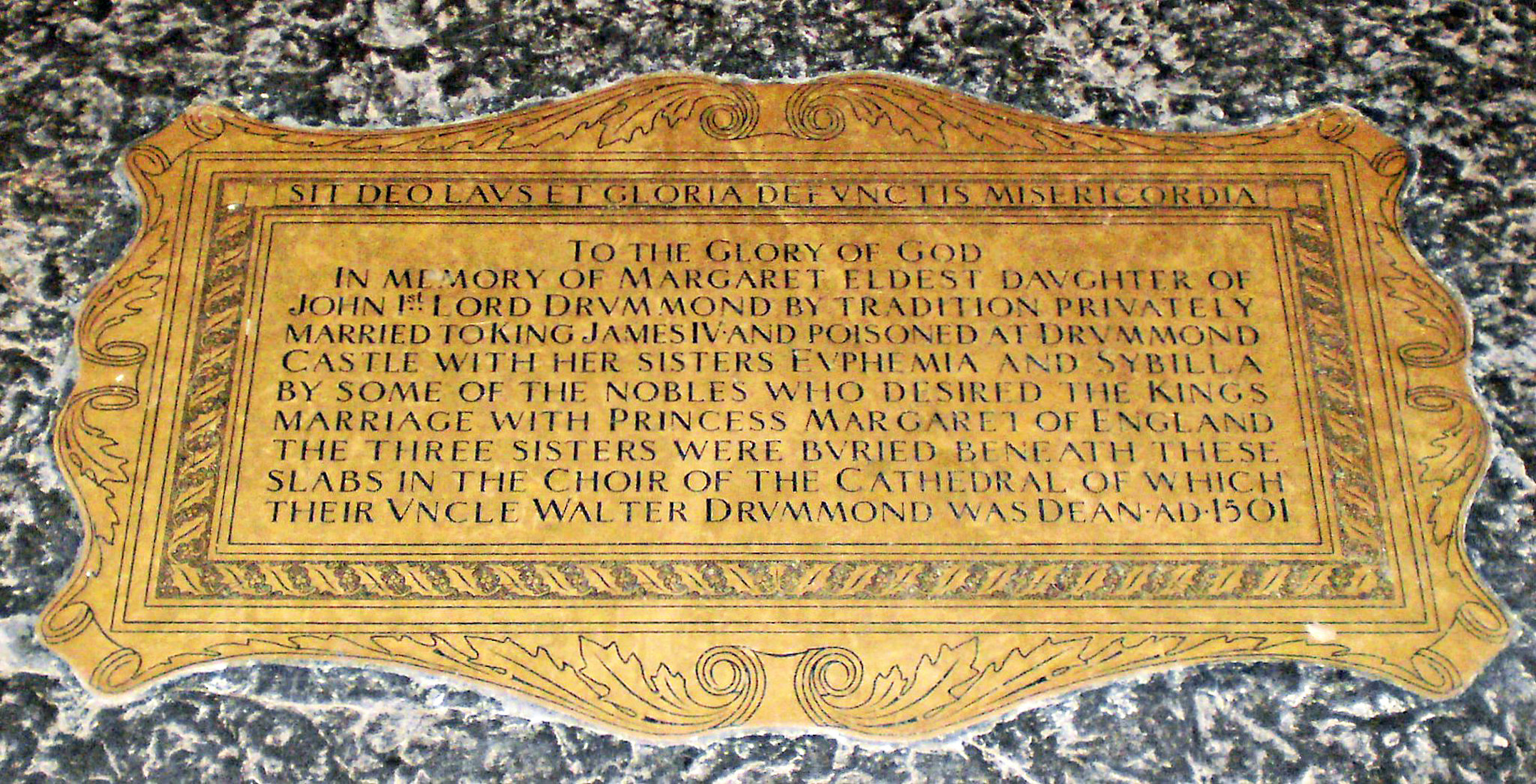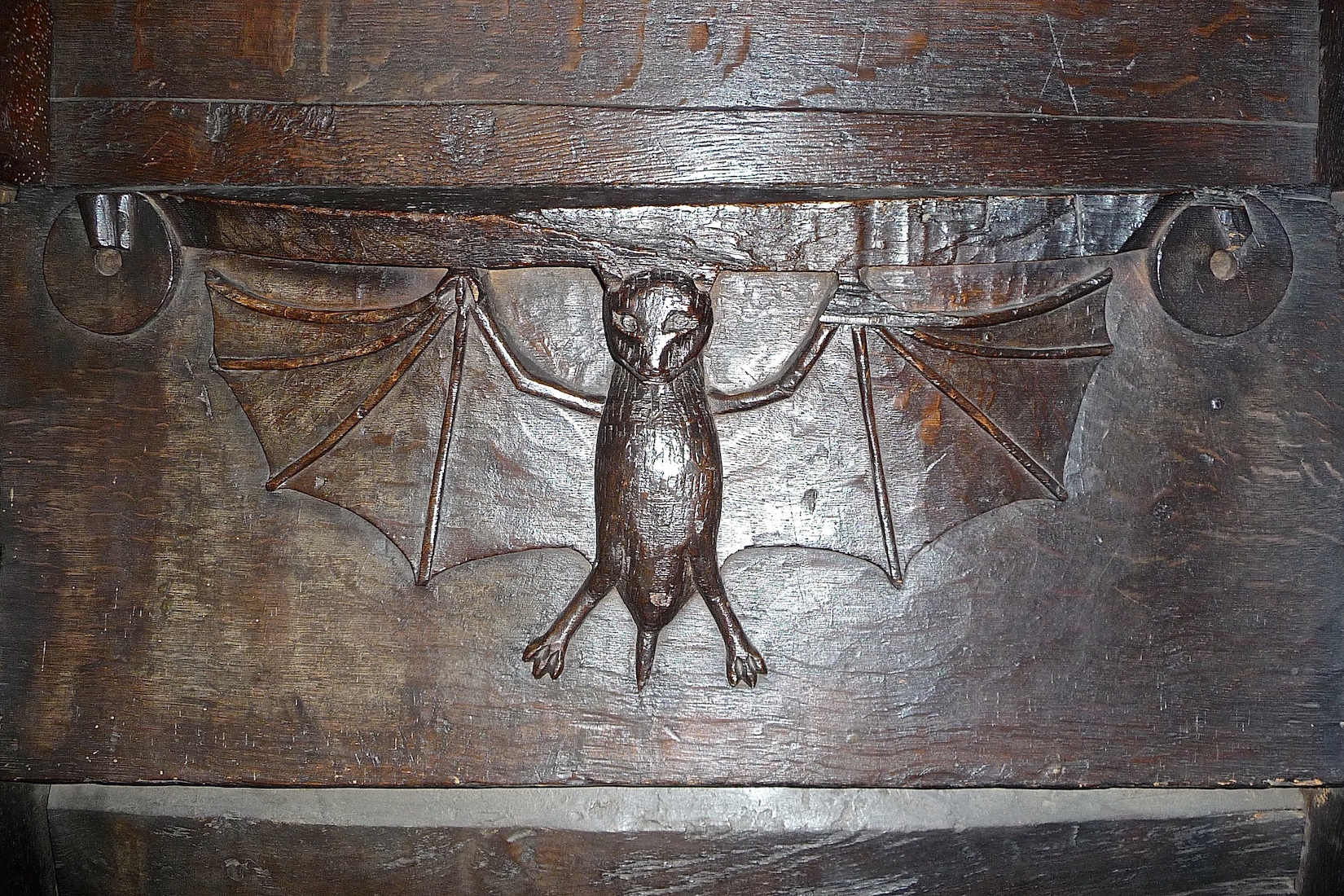


Three large brass plaques on the floor of the Choir show the burying places of the three Drummond sisters, Margaret, Euphemia and Sybilla. Margaret Drummond, said to have been secretly married to Scotland’s king, James IV, was the victim of political expediency and was poisoned with her two sisters at Drummond Castle by nobles who wished for the alliance with England which subsequently took place through the King’s marriage to Princess Margaret of England in 1503. Who says these were ‘the good old days’? A fourth plaque here tells of the replacement of old plaques. INDEX
62. CHOIR WINDOWS GA GA

The six Great South Windows of the Choir, installed in 1915, are the work of Louis Davis and are generally regarded as his finest work. They were presented by Sir Robert Younger, later Lord Blanesburgh, in memory of his mother. They portray the ‘Benedicite Omnia Opera’ - the song "O all ye works of the Lord, bless ye the Lord’ found in the apocryphal Additions to the Book of Daniel, one version of which is Psalm 148. The Easternmost three are shown here. • At left the archangels Michael and Gabriel are depicted. • Next is the Humanity Window: you might spot Adam and Eve at bottom right. • Next is the Earth Window, with its representations of animals, grass and water. At the top the dove, symbolising the Spirit of God, flies above the waters. There is a suggestion of salvation in the picture of the ark which carried Noah and his family through the flood.
63. CHOIR WINDOWS II GA GA

The next three windows, from left: • the Chaos Window, showing fire, storms, cold and snow ; at the bottom of which the five members of Scott’s ill-fated expedition to the South Pole in 1912 are named. • the Allegory Window shows the great features of the heavens: sun, moon, stars, clouds and the four winds. • Finally the window at right shows the remaining two archangels, Raphael and Uriel.
65. CHOIR STALLS GA GA
The misericord stalls date from the time of Bishop Ochiltree (1429-1447), and show fine carvings. The word misericord derives from the Latin for mercy – the extended top of the tip-up seats providing support for those who were tired standing through the long and frequent daily services. An unusual bat carving is shown at right. More details of the misericord carvings can be found here.
66. COMMUNION TABLE DC
Altar or communion table? Sometimes it is hard to tell! This communion table was designed by Anderson.
67. SCREEN DETAIL JG
The magnificent reredos screen, designed by Robert Lorimer, is in memory of Bishop Leighton. It represents the seven corporal acts of mercy. The seven corporal or bodily acts of mercy are based on Matthew 25:35, the centre of the parable of the sheep and the goats. From South to North they are: visiting the prisoner, receiving the stranger, giving drink to the thirsty, clothing the naked, visiting the sick and feeding the hungry. The seventh act, burying the dead, shown in the Northernmost section, was regarded as a fundamental obligation upon the faithful, as recorded in the apocryphal Book of Tobit. This panel is probably feeding the hungry.
68. RECESSED TOMB W:JS W:JS
On the North wall of the Choir is the effigy of a Bishop: because of its prominent position it is thought to be Clement. [Photo Credit: CCL Wikimedia: John Salmon]
69. EAST WINDOW GA
The Great East Window of the Choir was designed by Charles Eamer Kempe of London in 1901 – regarded as one of the finest of Victorian stained glass artists. It was a gift of Mrs Hay in memory of her husband John Alexander Hay of Cheltenham and his mother. The four central lights are divided into eight panels, showing, from bottom left, Gethsemane, the trial, Jesus carrying the cross, the crucifixion, the burial, the appearance to Mary of Magdala, the Emmaus meal and the charge to Peter. Each side light shows four Old Testament prophets, bringing into unity the scriptural testimony to Christ. On the north side from the top are David, Micah, Isaiah and Jeremiah, while on the south are Jonah, Ezekiel, Hosea and Zechariah.
70. PAVER GA
This completes our visit to Dunblane Cathedral. As I walk over this attractive paving stone near the West door, I read: ‘The earth is the Lord’s and everything in it’ – including Dunblane Cathedral!
CONCLUSION
I hope you have enjoyed visiting Dunblane Cathedral with me. As the first ‘write up’ of a Scottish cathedral, it has given me great pleasure.
The main contributing photographers to this site are ‘Glass Angel’, ‘Grangeburn’ and Sandy Cowan. I have been thrilled with the readiness of people to share their photos! Contributions are denoted by initials: GA, JG (Grangeburn) and SC. Originals of these photos can be found under the following links:
https://www.flickr.com/photos/47859152@N05/albums/72157718653883058 [GA]
https://www.flickr.com/photos/41583834@N03/albums/72157627844260898 [JG]
https://www.blogger.com/profile/05009803939431014995 [SC]
Also appearing here are a photograph by David Cleghorn (#32, DCl), several under the Creative Common Licence, CCL, and some from the Cathedral itself [DC]. These latter are acknowledged within the text.
I take little credit for the text which comes from a variety of different sources, although I have drawn heavily on the excellent ‘Virtual Tour’ notes of Dunblane Cathedral.
https://dunblanecathedral.org.uk/page/46/virtual-tour
I also express my thanks to my wife Margie who dutifully reads through all my websites and checks the typing.
I would be glad to receive any comments, criticisms or corrections to this site. The best websites are those which contain no errors!
Dunblane Cathedral has its own website with link:
https://dunblanecathedral.org.uk
Site created 06 / 2021
Paul Scott









